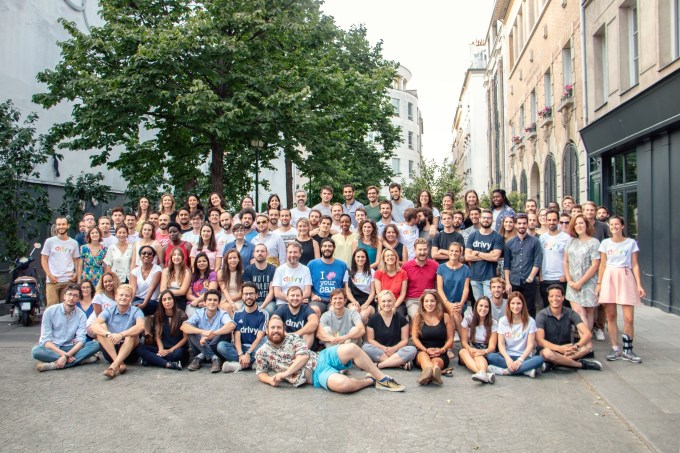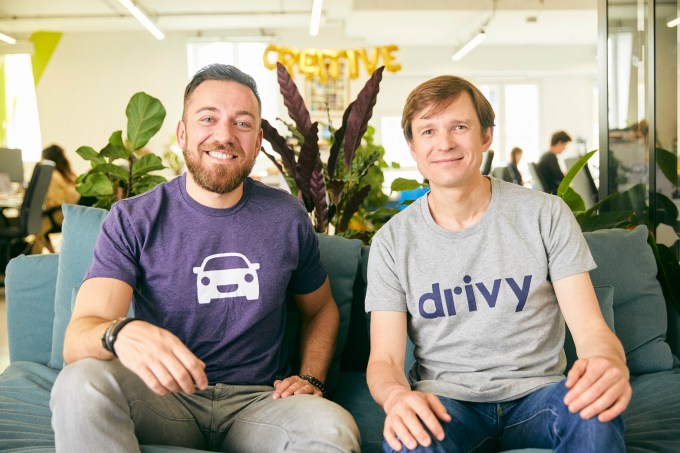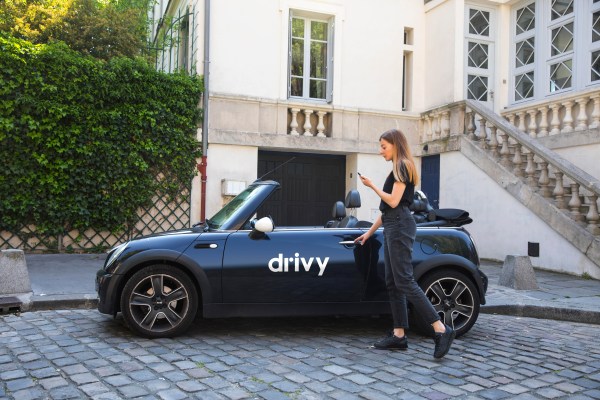In August of last year, Getaround scored $300 million from Softbank. Eight months later they handed that same amount to Drivy, a Parisian peer-to-peer car rental service that was Getaround’s ticket to tapping into European markets.

Alven Capital’s Jeremy Uzan
Both companies shared similar visions for the future of car ownership, they were about the same size, both were flirting with expanding beyond their home market, but only one had the power of the Vision Fund behind it.
The Exit is a new series at TechCrunch. It’s an exit interview of sorts with a VC who was in the right place at the right time but made the right call on an investment that paid off. [Have feedback? Shoot me an email at lucas@techcrunch.com]
Alven Capital partner Jeremy Uzan first invested in Drivy’s seed round in 2013. Uzan joined Index Ventures co-leading a $2 million round that valued the company at less than $10 million. The firms would later join forces again for the company’s $8.3 million Series A.
I chatted at length with Uzan about what lies ahead for the Drivy team, what Paris’s startup scene is still in desperate need of, and how Softbank’s power is becoming even more impossible to ignore.
The interview has been edited for length and clarity.
Getting the checkbook
Lucas Matney: So before we dive into this acquisition, tell me a little bit about how you got to the point where you were writing these checks in the first place.
Jeremy Uzan: So, I studied computer science and business and then spent three years as a tech banker. I was actually in a very small investment banking boutique in Paris helping young startups to raise their Series A rounds. They were all French companies, my first deal was with the YouTube competitor DailyMotion.
After those three years, I started with Alven. That was 11 years ago. Wow, that was a long time ago actually. I became a partner 5 or 6 years ago, and I’ve probably made between 20 and 25 investments in that time, 5 or 6 of which exited.
Some of Uzan’s other bets
Previous exits:
- Captain Train (acquired by Trainline)
- BIME Analytics (acquired by ZenDesk)
- MobPartner (acquired by Cheetah Mobile)
Active investments:
Lucas: Given your background, I’m curious what the jump was like when you moved from a boutique investment bank into VC. What were the differences?
Jeremy: It’s quite different actually. At the end of the day you’re trying to find the best companies as early as possible in both, but the difference is, as a pitch banker you just want to find a company that will succeed in its fundraising.
As a VC, you’re trying to find the best companies that will succeed as a business. I’m much more picky about the companies that I want to have in my portfolio as a VC because it’s my track record. I have to live with those founders for five, seven, ten years?
As a banker, you want to find a lot of companies with some interesting criteria, like a good founding team or an interesting space, then you know you will find some money in the market. So it’s quite different and it took me maybe two years to reset my mind.
Lucas: When you’re talking about resetting those parameters, what was the big challenge?
Jeremy: So right now, there are two kinds of VCs. You have the smart ones, but that’s not me. I’m more the gut-feeling guy. I have to feel that the team is interesting, smart, ambitious, like they’re the smartest people in the room and they’re working on something interesting. That’s it.
I’m quite sure in the end that having a great founding team and a not-so-great business is better than having to deal with what seems like a great business backed by a lousy founding team.
When you look at my portfolio it’s very heterogeneous. Half are B2B, half are B2C. I have deep tech companies and some low-tech companies. When you look at all of those founders in the same room, they’re nice people who are smart, ambitious and easy-going.
I think this is the way I’m going to continue investing, because I want to stay opportunistic and be able to jump on any project I see. It’s difficult for me to decide on just one market, then become an expert on all of the individual calculations of those financials. I’m not that kind of VC, I prefer to bet on people.

Drivy’s team
Making the connection
Lucas: So are you primarily investing with these founders in the seed stage or are you writing Series A checks after they’ve proved out the business a bit?
Jeremy: Usually we’re a Series A fund. In France, generally the Series A is the first institutional money, we don’t have a lot of pure seed funds out here. I’m almost always the first institutional investor in these companies and I’m always a board member.
Lucas: So what about Drivy? What stage was the company at when you met the founder?
Jeremy: So it was a long time ago, and to give you the context, at that moment Airbnb was already raising a lot of money from the top firms. So our firm’s reasoning was quite simple at the time, after your apartment, your car is the next very expensive thing that you own and that you don’t use it the vast majority of the time. So we started there and we thought, let’s do a deep dive on what could be a good peer-to-peer car rental player.
So I met with multiple very, very young startups and after these meetings we decided to back Drivy, which was called Voiturelib at the time which combines the French words for “car” and “freedom.” The name probably wasn’t the best choice for international expansion.
Anyway, we already had this great solo founder [Paulin Dementhon] and so the bet was mainly on him. We like the guy much better than the other four or five companies. We invested in the company in 2012, it was one of my first deals at Alven and was maybe 18 months after the company was created. I think there were three of four people at the time, so yeah, it was really just a bet on this guy and this feeling that we had at the moment that there could be a market here.
When we first covered Drivy in 2014, Dementhon told us he had initially flirted with an idea for the company that was closer to Uber than Getaround.
“I first played around the idea of building a ride-sharing service for short rides,” Drivy founder and CEO Paulin Dementhon he said. “But, little by little, I realized that there was another way to make cars useful again — by renting mostly unused cars.”
Lucas: What specifically got you so excited about Paulin?
Jeremy: So, he’s an interesting guy, he’s very good at understanding the dynamics of this market. He was also a product guy and we don’t have a lot of great product guys in France, and so that was a big strength at the time.
Lucas: What’s the startup scene look like in Paris overall?
Jeremy: It’s booming, we have more and more ambitious founders every year that create companies with a global ambition from the start and that just wasn’t the case five years ago. We have some very good engineering and business schools and more international talent that wants to live the startup life in Paris.
We have a lot of French VC funds, maybe because it’s a long tradition in France that the state helps to create these funds. The good VC funds are raising more and more. Alven is a good example, the fund that we raised two years ago was a €250 million fund, doubling the previous one of €120 million.
So, I mean, the whole ecosystem is moving, the only thing that we might be missing is the acquirers. The top exits that we have are mainly coming from the U.S. or Asian players. I would say that the French incumbents are not ready to pay the prices that we would accept for our startups.

Getaround CEO Sam Zaid and Drivy founder Paulin Dementhon
Getaround’s international expansion plan got its biggest kickstart with this deal. When we covered the company’s monster Series D last year, we noted their plans for the cash involved entering “into additional markets in the U.S. and internationally.”
When we chatted with Getaround’s CEO last month, he said that Drivy fit the bill for driving a big expansion.
“We were obviously looking at what our European strategy was and how we would expand out of the U.S. and into other parts of the world,” Getaround CEO Sam Zaid told TechCrunch. “When we started looking at Europe, it became clear Drivy was the market leader. They also shared the same vision.”
Recognizing Softbank’s power
Lucas: For Drivy, if Getaround hadn’t played the acquirer — though in a lot of ways this deal feels more like a merger — what kind of challenges would they have faced?
Jeremy: I would say international expansion. I mean, if you look at the story of Drivy, the inception of the company and the creation of the platform, then finding the first cars and drivers, then preparing the next generation outside of France, that was all the first step.
Then we did something truly important two years ago, which was creating Drivy Open, which let you open the car with your mobile app and enable instant bookings. So there, our next step was to just raise a lot of money to continue international expansion. It was just a question of can we find the right kind of money. If you don’t have what you need, it becomes a very painful job, because you know that you will be too weak to infiltrate the whole region and that can be very frustrating.
So we had this option of trying to find money, but it’s not easy to find a lot of it. And the other was exactly, this kind of merger, it’s true that it was almost a merger, I think we call this an acquisition because it is part-cash, part-shares, but the reason behind this is that Getaround raised a lot of money thanks to Softbank and so they had the ability to become the acquirer.
Lucas: So that $300 million round from Softbank closed a few months earlier and then this $300 million acquisition came together. Tell me about when this deal started forming.
Jeremy: So Paulin isn’t a shy guy, he’s not someone who doesn’t want to share KPI numbers, he’s quite open because he knows that it’s all about execution.
From a long time ago, he traveled to the U.S. and Asia to meet these people and so it’s possible that the relationship between Getaround and Drivy has been ongoing for a long time. As a board member, I found out about the discussions in the second half of last year.
I think that the Softbank deal made it obvious that we had to talk about Getaround. Before that, they were just a very attractive player in the space, but not so different.
To me, Softbank is just this giant in the market, and everything changes when Softbank enters the room. It’s also really a signal when they decide to invest in one player, and it means that company has cheaper access to capital which is a very, very strong weapon.
So when we heard that they got this money, the logical path became to partner with these guys. The discussion started like that, we didn’t want to sell the company, we just thought that we had to talk to Getaround because it was apparent that they would be around for quite a long time.
Lucas: So wrapping this up, I’m curious, without the huge Softbank round, there really wasn’t a huge difference in the amount of capital that these companies had raised, so do you think there’s an alternate universe where the deal could have gone the other way around?
Jeremy: No, no I don’t really think so.
Really the next step for Drivy was just raising a lot of money and then push, push, push into UK, Germany, Spain, Denmark and Belgium. I don’t even think the next, next step would have been the U.S., it would be a big step for European startup entering the U.S. market knowing that you already have a big competitor.
Lucas: Great, well thanks for taking the time to chat.
Jeremy: Thank you.
The Exit is a new, investor-focused series on TechCrunch. If you have feedback, input on a recent exit or would just like to chat, shoot me an email at lucas@techcrunch.com

